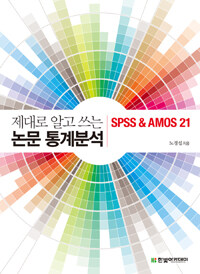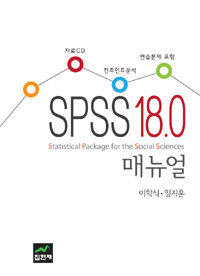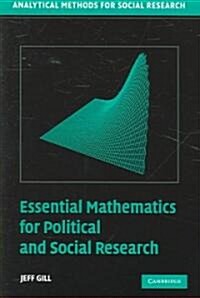
Introduction to mediation, moderation, and conditional process analysis: a regression-based approach
- 대등서명
- Mediation, moderation, and conditional process analysis
- 개인저자
- Andrew F. Hayes
- 판사항
- Second edition
- 발행사항
- New York : Guilford Press , 2018
- 형태사항
- xx, 692 pages : illustrations ; 27 cm
- ISBN
- 9781462534654 (hardcover)
- 청구기호
- 310.16 H417i
- 서지주기
- Includes bibliographical references (pages 637-667) and indexes
소장정보
| 위치 | 등록번호 | 청구기호 / 출력 | 상태 | 반납예정일 |
|---|---|---|---|---|
이용 가능 (1) | ||||
| 1자료실 | 00017996 | 대출가능 | - | |
- 등록번호
- 00017996
- 상태/반납예정일
- 대출가능
- -
- 위치/청구기호(출력)
- 1자료실
책 소개
?
New to This Edition
*Chapters on using each type of analysis with multicategorical antecedent variables.
*Example analyses using PROCESS v3, with annotated outputs throughout the book.
*More tips and advice, including new or revised discussions of formally testing moderation of a mechanism using the index of moderated mediation; effect size in mediation analysis; comparing conditional effects in models with more than one moderator; using R code for visualizing interactions; distinguishing between testing interaction and probing it; and more.
*Rewritten Appendix A, which provides the only documentation of PROCESS v3, including 13 new preprogrammed models that combine moderation with serial mediation or parallel and serial mediation.
*Appendix B, describing how to create customized models in PROCESS v3 or edit preprogrammed models.?
목차
I. Fundamentals
1. Introduction
1.1. A Scientist in Training
1.2. Questions of Whether, If, How, and When
1.3. Conditional Process Analysis
1.4. Correlation, Causality, and Statistical Modeling
1.5. Statistical and Conceptual Diagrams, and Antecedent and Consequent Variables
1.6. Statistical Software
1.7. Overview of This Book
1.8. Chapter Summary
2. Fundamentals of Linear Regression Analysis
2.1. Correlation and Prediction
2.2. The Simple Linear Regression Model
2.3. Alternative Explanations for Association
2.4. Multiple Linear Regression
2.5. Measures of Model Fit
2.6. Statistical Inference
2.7. Multicategorical Antecedent Variables
2.8. Assumptions for Interpretation and Statistical Inference
2.9. Chapter Summary
II. Mediation Analysis
3. The Simple Mediation Model
3.1. The Simple Mediation Model
3.2. Estimation of the Direct, Indirect, and Total Effects of X
3.3. Example with Dichotomous X: The Influence of Presumed Media Influence
3.4. Statistical Inference
3.5. An Example with Continuous X: Economic Stress among Small-Business Owners
3.6. Chapter Summary
4. Causal Steps, Confounding, and Causal Order
4.1. What about Baron and Kenny?
4.2. Confounding and Causal Order
4.3. Effect Size
4.4. Statistical Power
4.5. Multiple Xs or Ys: Analyze Separately or Simultaneously?
4.6. Chapter Summary
5. More Than One Mediator
5.1. The Parallel Multiple Mediator Model
5.2. Example Using the Presumed Media Influence Study
5.3. Statistical Inference
5.4. The Serial Multiple Mediator Model
5.5. Models With Parallel and Serial Mediation Properties
5.6. Complementarity and Competition among Mediators
5.7. Chapter Summary
6. Mediation Analysis with a Multicategorical Antecedent X
6.1. Relative Total, Direct, and Indirect Effects
6.2. An Example: Sex Discrimination in the Workplace
6.3. Using a Different Group Coding System
6.4. Some Miscellaneous Issues
6.5. Chapter Summary
III. Moderation Analysis
7. Fundamentals of Moderation Analysis
7.1. Conditional and Unconditional Effects
7.2. An Example: Climate Change Disasters and Humanitarianism
7.3. Visualizing Moderation
7.4. Probing an Interaction
7.5. The Difference between Testing for Moderation and Probing It
7.6. Artificial Categorization and Subgroups Analysis
7.7. Chapter Summary
8. Extending the Fundamentals of Moderation Analysis
8.1. Moderation with a Dichotomous Moderator
8.2. Interaction between Two Quantitative Variables
8.3. Hierarchical versus Simultaneous Entry
8.4. The Equivalence between Moderated Regression Analysis and a 2 × 2 Factorial Analysis of Variance
8.5. Chapter Summary
9. Some Myths and Further Extensions of Moderation Analysis
9.1. Truths and Myths about Mean Centering
9.2. The Estimation and Interpretation of Standardized Regression Coefficients in a Moderation Analysis
9.3. A Caution on Manual Centering and Standardization
9.4. More than One Moderator
9.5. Comparing Conditional Effects
9.6. Chapter Summary
10. Multicategorical Focal Antecedents and Moderators
10.1. Moderation of the Effect of a Multicategorical Antecedent Variable
10.2. An Example from the Sex Discrimination in the Work Place Study
10.3. Visualizing the Model
10.4. Probing the Interaction
10.5. When the Moderator is Multicategorical
10.6. Using a Different Coding System
10.7. Chapter Summary
IV. Conditional Process Analysis
11. Fundamentals of Conditional Process Analysis
11.1. Examples of Conditional Process Models in the Literature
11.2. Conditional Direct and Indirect Effects
11.3. Example: Hiding Your Feelings from Your Work Team
11.4. Estimation of a Conditional Process Model using PROCESS
11.5. Quantifying and Visualizing (Conditional) Indirect and Direct Effects
11.6. Statistical Inference
11.7. Chapter Summary
12. Further Examples of Conditional Process Analysis
12.1. Revisiting the Disaster Framing Study
12.2. Moderation of the Direct and Indirect Effects in a Conditional Process Model
12.3. Statistical Inference
12.4. Mediated Moderation
12.5. Chapter Summary
13. Conditional Process Analysis with a Multicategorical Antecedent
13.1. Revisiting Sexual Discrimination in the Work Place
13.2. Looking at the Components of the Indirect Effect of X
13.3. Relative Conditional Indirect Effects
13.4. Testing and Probing Moderation of Mediation
13.5. Relative Conditional Direct Effects
13.6. Putting It All Together
13.7. Chapter Summary
V. Miscellanea
14. Miscellaneous Topics and Some Frequently Asked Questions
14.1. A Strategy for Approaching a Conditional Process Analysis
14.2. How Do I Write about This?
14.3. Should I Use Structural Equation Modeling Instead of Regression Analysis?
14.4. The Pitfalls of Subgroups Analysis
14.5. Can a Variable Simultaneously Mediate and Moderate Another Variable's Effect?
14.6. Interaction between X and M in Mediation Analysis
14.7. Repeated Measures Designs
14.8. Dichotomous, Ordinal, Count, and Survival Outcomes
14.9. Chapter Summary
Appendices
Appendix A. Using PROCESS
Appendix B. Constructing and Customizing Models in PROCESS
Appendix C. Monte Carlo Confidence Intervals in SPSS and SAS
References
About the Author




